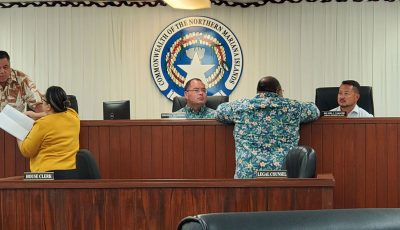Protecting CUC
The $690,000 emergency procurement of a 27-year-old, used 2-megawatt backup generator for Rota is just the latest example of how CUC ratepayers in the Commonwealth continue to be taken advantage of. Here are some additional examples:
• a $190-million sole source power plant purchase that led to the impeachment of a former sitting governor;
• a $180-million reverse osmosis system that would have tripled the water rates for CUC customers while still failing to address water leaks and water theft; and
• the fraudulent emergency purchase of an 8- to 10-megawatt generator that led to two oversight hearings and the discovery of fraud and collusion and the eventual removal of a former CUC board.
And there are more examples of the fleecing of CUC, but we can save those for a future letter.
Here’s the first of three questions that should be asked by CUC ratepayers, the Office of the Attorney General, and the Office of the Public Auditor about this $690,000 emergency procurement purchase of a 27-year-old, used 2-megawatt backup generator for Rota: Is this the best deal we can get?
As I write this, there are replacement parts, sitting on Saipan, for a Caterpillar generator already on Rota. The parts are in a container, ready to be shipped. If this container were to be delivered to Rota tomorrow and used to repair a generator already on Rota, it would save CUC ratepayers from paying $690,000 for a backup generator. Since the parts are already here on Saipan and it would take a day or less to get to Rota, once the generator is repaired and rehabilitated by qualified mechanics, this generator could be the backup generator Rota needs right now.
There is also another option. CUC purchased a brand-new 2-megawatt generator engine from Singapore-based M&E Engineering & Logistics Supply, and this engine is expected to be on Saipan within two to four months from the NTP (notice to proceed) date, which was near the end of January. This brand-new engine cost $315,000, and that includes shipping costs to Saipan. This $315,000 price tag is less than half the cost of the $690,000 backup generator. More importantly, once this brand-new engine is installed (installation is estimated to take one to two weeks), it will be the primary power source for Rota.
A best-case scenario is this $315,000 brand-new engine could be up and running by the first week of April. A worst-case scenario is that it won’t be installed until the first or second week of June. If the CUC board and management were to contact M&E and provide incentives or pay perhaps an additional $50,000 for this brand-new engine to be expedited, it would still save the CNMI $640,000.
It is important to note that once this brand-new engine from M&E is running, the 2-megawatt Mitsui engine, which is currently running Rota’s power and was rehabilitated just a few days ago, will be the primary backup generator for Rota. And once the Caterpillar generator parts that are stranded on Saipan finally get sent to Rota and the Caterpillar generator is repaired, this rehabilitated engine could be the second backup generator for Rota. And as a third option and as a last resort, there is the Rota Resort generator, which may be expensive at 19 cents per kilowatt hour but is still an available emergency option and would be used only should Rota need emergency backup power and everything else fails.
A second question that must be asked by CUC ratepayers, the attorney general, and the public auditor: Why are CUC ratepayers paying for the rental of a crane when this expense should clearly be paid for by Rota Terminal and Transfer), the company that is solely responsible for Rota’s stevedoring operations?”
This crane has been down for many months, and what has CPA done thus far to get the crane back in operation? How is it even legal that CUC ratepayers should shoulder the costs of renting, shipping, and operating an 80-ton crane when RT&T is responsible for crane operation and CPA is responsible for enforcement of RT&T’s contractual obligations? For the past several months, we have seen the people of Rota suffer because of this broken crane. How is this not prioritized? Why are there no penalties in place for the failure to abide by a contract that requires an operating crane? Who is responsible for enforcing this? The people of Rota are suffering because a contractual obligation is not being enforced, and now every CUC ratepayer must pay for it. This isn’t right.
In the $690,000 procurement of this used 2-megawatt generator for Rota, there is a $160,000 freight charge included in the cost. That $160,000 charge is an astronomical price tag when you consider it costs less than $9,000 to ship a fully loaded 40-foot container from the East Coast to Saipan. Can this $160,000 shipping cost be explained and can invoices and receipts be provided? I would like to see them. I am sure the rest of the CNMI’s CUC ratepayers would as well, and so too should the attorney general and the public auditor. But we have been told that the $160,000 shipping cost includes the shipment of an 80-ton crane. Because of the failure of CPA and RT&T to provide crane service for the people of Rota, should every CUC ratepayer in the CNMI have to see another increase in their utility rates to pay for this $690,000 backup generator that includes the shipping, plus the rental of an 80-ton crane? The only way to pay for this is to raise CUC rates, as this backup generator is not being paid for by the Department of the Interior or with federal money.
A third question that must be asked by the attorney general, the public auditor, and CUC ratepayers: After all the scandals we have seen at CUC, how is it possible that the CUC board and management has not created strict debarment rules and regulations that would suspend or ban nefarious companies and individuals from doing business with CUC?
Debarment rules and regulations exist to protect the interests of the federal and local government and its agencies. Debarment may be imposed when a contractor is convicted of or found civilly liable for any integrity offense. Integrity offenses include the following:
• Fraud or criminal offenses in connection with obtaining, attempting to obtain, or performing a public contract;
• Violations of federal or state anti-trust laws relating to the submission of offers;
• Embezzlement, theft, forgery, bribery, falsification or destruction of records;
• Making false statements, tax evasion, or receipt of stolen property; and
• Other offenses indicating a lack of business integrity or honesty that seriously affect the present responsibility of a contractor.
It is my sincere hope that CUC works with the Office of the Attorney General and the Office of the Public Auditor to develop debarment rules and regulations that can protect the interests of CUC and its ratepayers from future scandals or scams.
We all must be cognizant of the fact that our Commonwealth is faced with a huge deficit of over $26 million. Now more than ever is the time for every agency to be fiscally conservative and prudent in its spending and to carefully and thoroughly review every contract, most especially ones that may not be absolutely necessary. I urge the CUC board and its management to meticulously explore every option that I have mentioned before purchasing a 27-year-old, used 2-megawatt generator and paying for the rental of an 80-ton crane service that should be provided for by Rota’s stevedoring company, RT&T. $690,000 is a significant amount of money, most especially when it may not need to be spent since there are other options on the table.
***
Edwin K. Propst is a member of the House of Representative in the 21st CNMI Legislature.



























